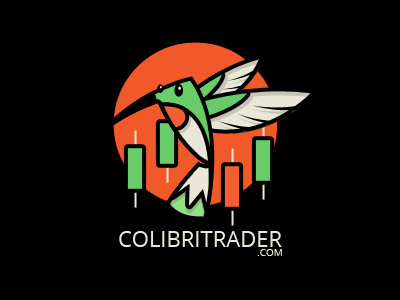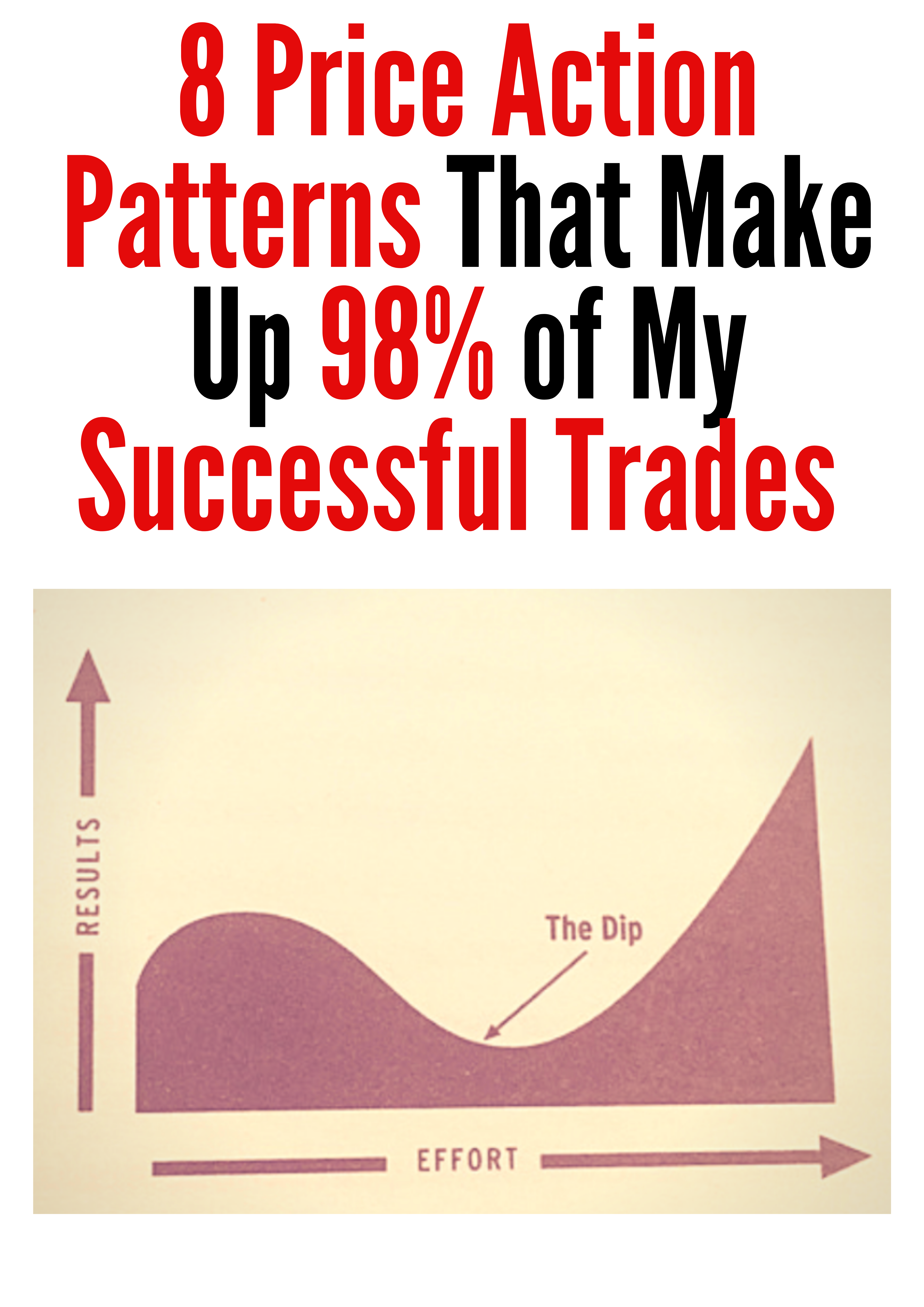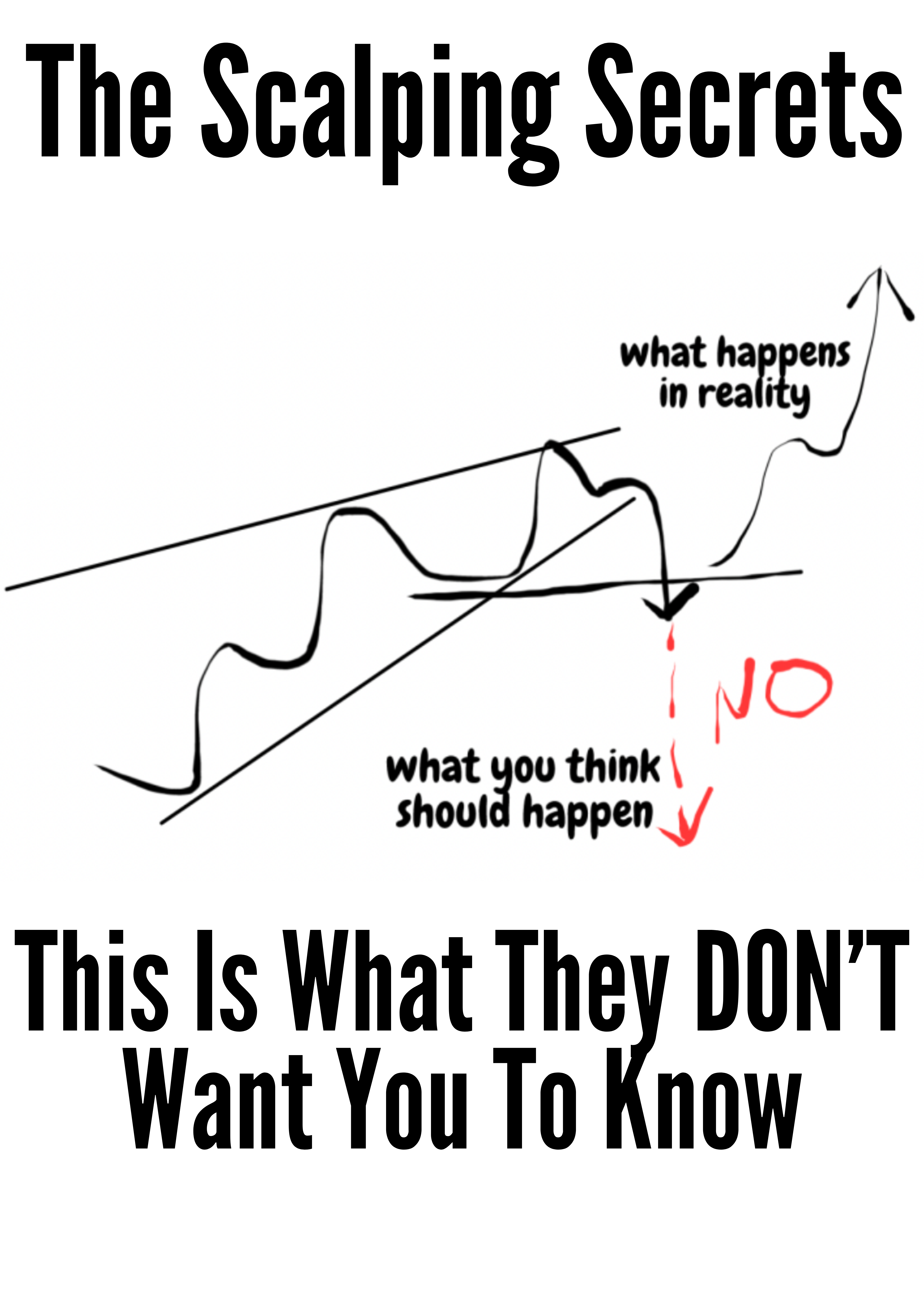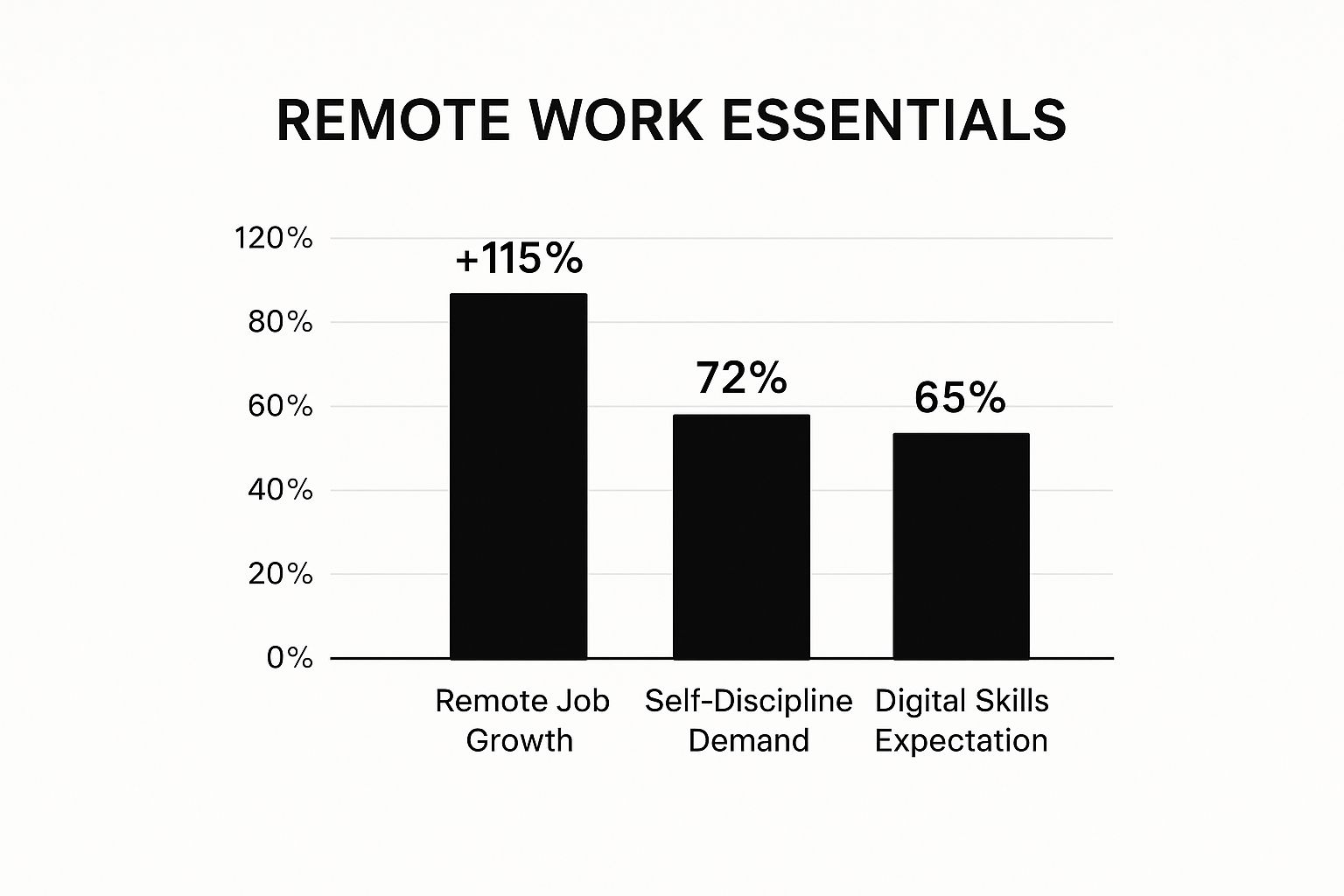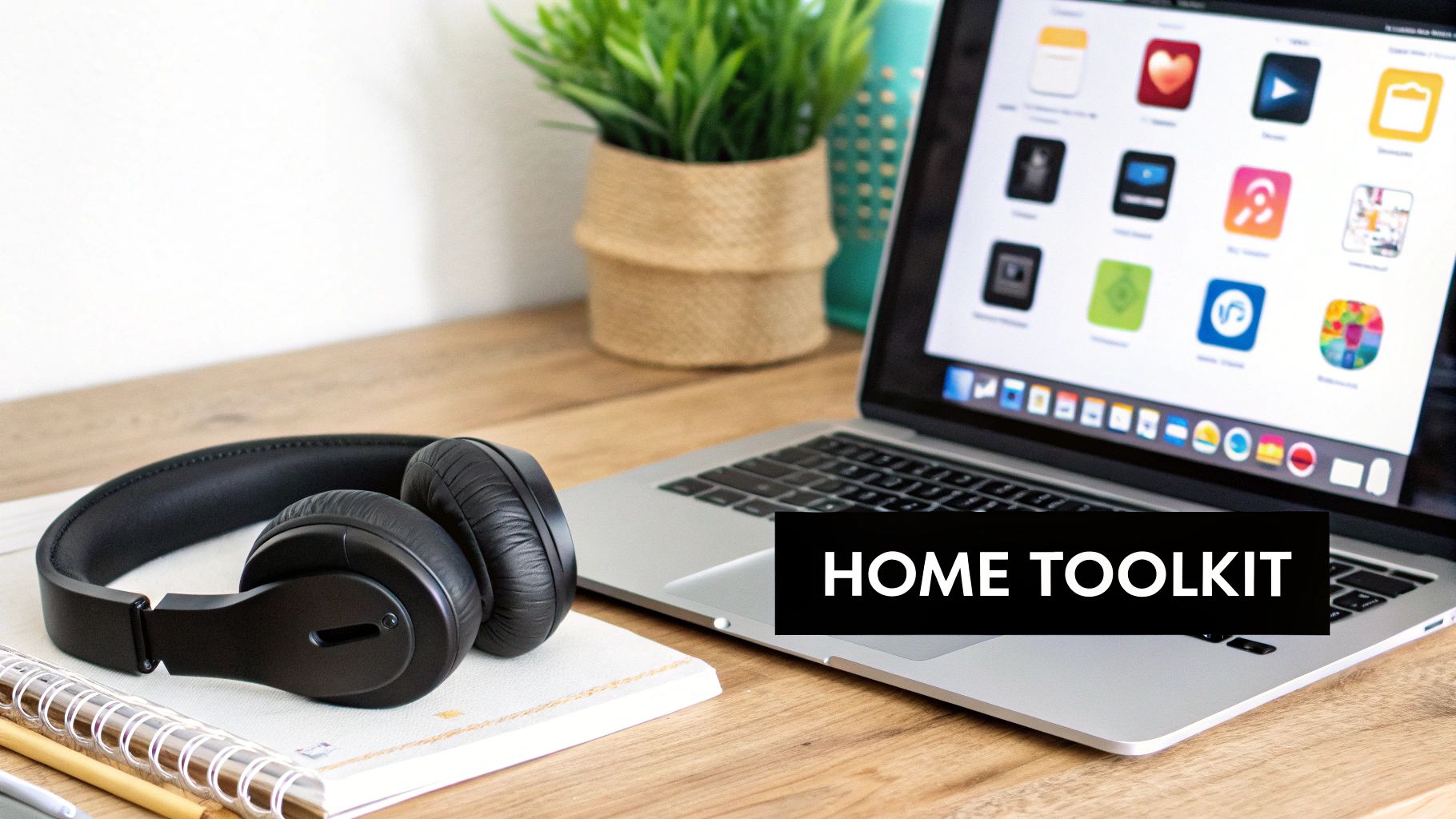How to Make Money From Home A Practical Guide
The dream of making money from home is no longer just a fantasy. It's more achievable now than ever before, but let's be clear: it requires a real plan, not just wishful thinking. The secret sauce is combining a skill people will pay for with a healthy dose of consistency and self-discipline. This guide is your no-nonsense roadmap to building a real, sustainable income from your own space.
Your Realistic Path to Working From Home
Let's cut through the hype. Earning a living without the daily commute is an incredibly attractive idea, and the good news is, it's a genuine option for millions. The global shift towards flexible work has opened up a massive ecosystem for earning an income from home. This isn’t a passing trend; it's a fundamental change in how we think about work.
The numbers don't lie. In 2023, around 28% of employees worldwide worked remotely, a huge leap from just 20% back in 2020. This translates into tangible opportunities. Freelance platforms like Upwork and Fiverr are pulling in over $3.3 billion in annual revenue, fueled by this growing remote workforce.
Setting Honest Expectations
While the opportunities are there for the taking, success isn't handed to you. Making money from home requires a different kind of mindset than your typical 9-to-5. You're the boss now, which also means you're the manager, the IT guy, and your own motivational coach.
This infographic does a great job of breaking down what's driving the modern remote work scene.
As you can see, remote job growth is exploding, but so is the demand for people who are self-disciplined and comfortable with digital tools.
Your journey has to start with an honest look at your skills and what you really want. Are you aiming for a side hustle to bring in some extra cash, or are you trying to build a full-time career? The path you take depends entirely on that answer. For some, freelance writing or virtual assistance might be the perfect fit. For others with an eye for the markets, learning the ropes of becoming a day trader from home could be the goal.
It's crucial to know the difference between a short-term gig and a sustainable career. A gig pays the bills this month. A career builds wealth and gives you long-term financial security. You want to align your efforts with building a career.
So, how do you find the right path? Let's break down some of the most common options to give you a clearer picture.
Choosing Your Work From Home Income Model
This table breaks down the most common ways to earn from home, comparing their income potential, required startup time, and necessary skill levels to help you choose the right path.
| Income Model | Typical Income Potential | Time to First Dollar | Required Skill Level |
|---|---|---|---|
| Freelancing | $500 – $10,000+ /mo | 1-4 Weeks | Varies (Beginner to Expert) |
| E-commerce | $1,000 – $25,000+ /mo | 1-3 Months | Intermediate |
| Affiliate Marketing | $300 – $5,000+ /mo | 3-6 Months | Beginner to Intermediate |
| Trading | Varies widely | 1-6+ Months | Intermediate to Advanced |
| Online Courses | $200 – $10,000+ /mo | 2-4 Months | Expert |
| Virtual Assistant | $500 – $4,000+ /mo | 2-4 Weeks | Beginner |
Each of these paths has its own set of challenges and rewards. The key is finding the one that aligns best with your existing skills, your financial goals, and the amount of time you can realistically commit.
To get started on solid ground, focus on these core principles:
- Pinpoint a Valuable Skill: What can you do that businesses or individuals will gladly pay for? This could be anything from graphic design and coding to customer support or financial trading.
- Create a Real Plan: Don't just "wing it." Outline your goals, figure out who your target clients or market are, and map out the specific steps you'll take to get there.
- Master Self-Discipline: With no boss looking over your shoulder, your success falls squarely on you. You have to stay focused, manage your time wisely, and consistently produce quality work.
This guide is designed to give you a clear-eyed view of both the amazing opportunities and the real challenges, so you can start your journey with confidence.
How to Find and Validate a Profitable Idea
The whole game of making money from home hinges on a solid idea. But let's be clear: a "great idea" isn't some lightning bolt of inspiration that strikes you in the shower. It's the sweet spot where what you're good at, what you actually enjoy, and what people will pay for all meet. Forget brainstorming in a vacuum. The most profitable concepts are born from listening to what's happening around you.
Your first move is to look inward, not at some generic list of "top 10 online businesses." What skills have you already picked up? And I mean really think beyond your official job title. Maybe you're the friend everyone goes to for resume advice, the family member who plans every vacation down to the minute, or the one who can turn a chaotic garage into a perfectly organized space.
These aren't just hobbies; they're the raw materials for a business. I have a friend who was always incredibly organized. She translated that natural talent into a virtual assistant business, starting by just helping a few friends manage their schedules. Now, it's her full-time career, run entirely from her living room.
Uncovering Market Needs in the Wild
The best ideas solve real, nagging problems. To find those problems, you have to become an expert listener. Go hang out where your potential customers are already talking.
- Facebook Groups: Jump into groups related to your professional skills or personal interests. Look for the same questions popping up over and over. Is everyone tearing their hair out over creating social media content? Are small business owners constantly asking for bookkeeping advice? These are giant, flashing signs of demand.
- Reddit and Quora: Subreddits and Quora threads are absolute goldmines for unfiltered customer pain points. People aren't there to look smart; they're genuinely asking for help. A post titled, "How do I get my Shopify store to actually make sales?" is a direct signal of a market need you could fill.
- Product Reviews: Go read the reviews for products or services in a niche that interests you. What are the common complaints? The one-star reviews are often the most valuable, highlighting gaps in the market just waiting for someone like you.
When you immerse yourself in these conversations, you stop guessing what people want and start knowing what they need. You’ll see patterns in their frustrations—and those patterns are the seeds of your next profitable venture.
The goal isn't always to invent something completely new. Often, it's far more profitable to find an existing need and simply serve it better, faster, or with a more personal touch than anyone else.
Testing Your Idea Before You Build
So, you've got an idea. The single biggest mistake you can make now is to lock yourself away for months building it out, only to find out nobody wants to buy it. Validation isn't optional; it's the critical step that separates a real home business from just an expensive hobby. You have to test the waters first.
As you start mapping out your business, exploring successful models and gaining insights into tiny startups can give you a practical framework for this validation process. It's a great way to see how others have successfully navigated this exact stage.
Here are a few simple, low-cost ways to validate your idea:
- Run a Social Media Poll: Use Instagram Stories or a quick Facebook poll to ask direct questions. If you're considering a meal-planning service, you could ask, "What's your single biggest challenge with weeknight dinners?" The answers you get are immediate, valuable feedback.
- Do Some Keyword Research: Pop over to a free tool like Google Keyword Planner and see how many people are searching for terms related to your idea. A high search volume for "freelance graphic designer for small business" is hard proof that an active market is out there looking for a solution.
- Create a Simple Landing Page: You don't need a full website. Just set up a single page describing your service or product with a clear call-to-action like "Join the waitlist" or "Get notified on launch." If you can collect 50-100 email addresses, you've just confirmed genuine interest.
This phase isn't about making sales—it's about gathering data. Every poll response, keyword search, and email signup is a vote of confidence in your idea. It’s the proof you need to start building your toolkit and finding those first clients, knowing you're already on the right track.
Building Your Home-Based Business Toolkit
Once you've landed on a profitable idea and know it has legs, it's time to build your command center. Knowing how to make money from home isn't just about what you sell; it's about having the right setup to deliver it like a pro. Forget the fancy office and massive budget. What you really need is a smart, streamlined toolkit that lets you operate on par with anyone, right from your kitchen table.
This is about creating a seamless workflow for everything from managing projects to talking with clients. Getting this right frees you up to focus on the tasks that actually bring in the cash. It proves that professionalism comes from your process, not your postcode.
The Non-Negotiable Tech Foundation
Before we get into specific software, let's talk about the absolute must-haves. This is the bedrock your entire home-based business will be built on. Skimping here is like building a house on a shaky foundation—it's just asking for trouble down the line.
- Reliable High-Speed Internet: Your internet is your lifeline. Shoddy service leads to dropped client calls, missed deadlines, and a reputation for being flaky. Invest in the best connection you can afford; it's a non-negotiable business expense.
- A Dedicated Workspace: This doesn’t mean you need a separate room, but you absolutely need a dedicated spot. A specific desk and a good chair tell your brain it's time to work, which does wonders for focus and productivity. It also helps create that crucial boundary between work life and home life. For traders, a well-planned desk is especially critical; you can find some great advice on creating an optimal https://www.colibritrader.com/home-trading-setup/ that cuts out distractions.
- Professional Communication Tools: Your personal email just won't cut it. Set up a dedicated business email address. For video calls, get comfortable with standard platforms like Zoom or Google Meet, and please, invest in a decent webcam and microphone. It makes a world of difference.
Getting these core pieces right ensures your operation runs smoothly and you look like a total pro to every single client.
A professional toolkit does more than just help you get the work done; it builds client confidence. When your invoices are clean, your project updates are clear, and your communication is crisp, clients trust you're a serious operator who can deliver.
Essential Software For A Lean Operation
With the foundation sorted, you can layer on some powerful, low-cost software to manage the day-to-day. The goal is to pick tools that simplify your workload, not add to it. The good news is, many of the best options are free or have "freemium" plans that are perfect when you're just starting out.
Here are my top picks for a lean but highly effective business toolkit:
- Project Management (Asana or Trello): Stop trying to run your business on sticky notes. Tools like Asana or Trello use visual boards that let you track every project from start to finish. You can create checklists, set deadlines, and see exactly what's on your plate at a glance. I've found their free versions are more than enough for most solo operators.
- Invoicing and Accounting (Wave): You have to get your money right from day one. Wave offers completely free invoicing, accounting, and even receipt scanning specifically for small businesses. You can send professional invoices, track who has paid, and run basic reports without spending a dime.
- Cloud Storage (Google Drive or Dropbox): Keep your files organized, secure, and accessible from anywhere. Google Drive gives you a generous 15 GB of free storage, which is plenty for most freelancers to store contracts, project files, and client documents.
Of course, to really connect with clients, you need a professional online presence. A great resource for this is a guide that shows you how to create a small business website, walking you through the essentials step-by-step.
Combining these tools creates an ecosystem that practically automates the admin side of your business. That leaves you free to focus on what really matters: delivering great work and growing your income.
A Practical Guide to Finding Your First Clients
Building a fantastic service is only half the battle. If nobody knows you exist, you’ve got a hobby, not a home-based business. This is where the real work begins—marketing yourself and landing those first crucial clients to get the ball rolling. The good news? You don't need a huge marketing budget, just a smart, consistent strategy.
We're going to walk through a few practical approaches, from tapping into your personal network (without being weird about it) to creating a killer profile on platforms like Upwork or Toptal. The key is taking small, targeted actions every single day to get your name out there and lock in those initial projects.
Tap Into Your Warm Network First
Your first client is often closer than you think. Before you even think about cold outreach, take a look at your existing network: friends, family, and former colleagues. This isn't about awkwardly begging for work; it’s about professionally announcing your new venture.
A simple, friendly email or social media post can do wonders. Just explain what you’re doing, who you’re trying to help, and what problems you solve. You’d be surprised how many people in your circle know someone who needs exactly what you offer.
Don't ask your network for business. Ask them if they know anyone who might benefit from your services. This simple shift in language turns a potentially awkward ask into a request for a helpful introduction, which most people are happy to provide.
For instance, a message could look something like this:
"Hey everyone, exciting news! I've officially launched my freelance web design service, focusing on helping local businesses build a professional online presence. If you know any small business owners struggling with their website, I'd be grateful for an introduction!"
Build a Simple, Powerful Portfolio
"But I don't have any clients, so I don't have a portfolio!" It's the classic chicken-and-egg problem, but it's easily solved. You don't need paid work to show off your skills.
Create a few high-quality "spec" projects. Think of them as self-initiated projects that demonstrate your abilities as if they were for a real client.
- For a writer: Write three blog posts on topics in your target niche.
- For a designer: Redesign the logo and landing page for a local business you admire.
- For a virtual assistant: Create a sample social media content calendar for an imaginary brand.
These pieces prove you can deliver the goods. A portfolio with three excellent spec projects is infinitely better than having nothing to show. It demonstrates initiative and gives potential clients the confidence they need to hire you.
Master Freelance Platforms and Cold Outreach
With your portfolio ready, it’s time to actively hunt for opportunities. Freelance platforms and direct outreach are two of the most powerful channels for anyone looking to make money from home.
Optimizing Your Freelance Profiles
Platforms like Upwork, Fiverr, and industry-specific sites like Toptal are full of clients actively looking for help. Success here isn't about being the cheapest; it's about standing out.
- Complete Your Profile 100%: Use a professional headshot and write a bio that focuses on benefits. Instead of saying "I am a graphic designer," try "I help startups create memorable brands through clean, impactful design."
- Showcase Your Best Work: Upload those spec projects to your portfolio section. Make it the first thing potential clients see.
- Write Custom Proposals: Never, ever use a generic, copy-paste proposal. Address the client's specific pain points from their job post and briefly explain how you are the right person to solve them.
The Art of the Cold Email
Cold emailing still works wonders when you do it right. The key is to make it about them, not you. Research your target, find a specific person (like a marketing manager or founder), and write a short, personalized email.
Here’s a simple template that actually gets responses:
| Section | Content | Example |
|---|---|---|
| Subject Line | Quick Question about [Their Company Name] | Quick Question about Acme Inc. |
| Opening Line | A genuine, specific compliment. | I was really impressed by the recent article on your blog about sustainable packaging. |
| The Pitch | Briefly state the problem you solve and offer value. | I noticed the mobile version of your site takes a bit long to load. I specialize in optimizing site speed for e-commerce brands, which often boosts conversion rates. |
| Call to Action | A simple, low-pressure question. | Would you be open to a brief chat next week to discuss a few ideas? |
This approach shows you've done your homework and are genuinely focused on helping them. By combining these strategies—tapping your network, building a spec portfolio, and engaging in targeted outreach—you create a powerful system for consistently landing your first paying clients.
How to Set Your Prices and Manage Your Finances
Figuring out how much to charge is probably the most nerve-wracking part of working from home. It's easy to fall into the imposter syndrome trap, lowballing your rates just to get your foot in the door. We need to stop that right now. Setting your price isn't just about getting paid; it's a signal to the market about the value you bring.
Let's move away from guesswork and into a real strategy. We'll break down the most common ways to price your work and, just as important, the financial habits you absolutely must build from day one.
Choosing Your Pricing Model
How you structure your fees directly shapes your income and daily workflow. There’s no magic "best" way to do it; the right model really depends on what you do and what your clients are comfortable with.
You'll almost always run into one of these three models:
- Hourly Rate: This is the most straightforward approach. You charge a flat rate for every hour you put in. It's a great fit for projects with a fuzzy scope or those that might evolve over time, like ongoing consulting or unpredictable troubleshooting tasks.
- Per-Project Rate: You set one fixed price for the entire job. This is perfect when the deliverables are crystal clear—think designing a logo, writing a 5-page website, or editing a short video. Clients often love this model because the cost is predictable from the start.
- Retainer Fee: This is the gold standard for creating predictable, stable income. A client pays you a set amount every month to secure your services for a certain number of hours or tasks. This model is built for long-term relationships, like managing a company's social media or handling their monthly SEO.
A freelance writer just starting out might use an hourly rate to gauge how long it takes to produce quality content. Once they have a better feel for their own process, they might shift to a project rate, like charging $500 for a 1,500-word article. The ultimate goal could be landing a retainer with a great client for $2,000 per month to deliver four articles and help manage their blog.
The Financial Essentials of Self Employment
That first payment hitting your account is a huge rush. But what you do after the money arrives is what separates a sustainable business from a stressful hobby. When you're the boss, you're also the entire HR and accounting department. You can't afford to ignore this.
First rule: separate your business and personal finances immediately. Open a dedicated business checking account the moment you start earning. This one simple step will save you countless headaches when it comes to tracking expenses and filing taxes. It draws a clean line in the sand.
Your gross income is not your take-home pay. The single biggest mistake new freelancers make is spending every dollar that comes in. A huge chunk of that money belongs to the taxman, and it’s your job to put it aside.
This brings us to the most critical financial habit you need to build.
Managing Taxes and Tracking Expenses
When you're self-employed, no one is withholding taxes for you. That responsibility falls squarely on your shoulders. A good, safe rule of thumb is to immediately move 25-30% of every single payment into a separate savings account labeled "Taxes." Don't even think about touching it.
At the same time, you have to become a meticulous record-keeper. Why? Because every legitimate business expense can lower your taxable income, meaning you keep more of your hard-earned money.
Keep a running list of everything, including:
- Software Subscriptions: Any tools you use for work, from project management apps to design software.
- Home Office Expenses: A percentage of your rent/mortgage and utilities if you have a dedicated workspace.
- Marketing Costs: Things like website hosting, business cards, or any online ads you run.
- Professional Development: Online courses, industry books, or conference tickets that help you improve your skills.
You don't need a complicated system. Simple accounting software like Wave or even a well-organized spreadsheet can do the job.
This kind of financial discipline is what builds a healthy business. For those in fields like trading, the core concepts are identical—understanding profit, loss, and risk is everything. Applying the principles of money management in trading to your freelance finances will ensure you're actually building a profitable enterprise, not just a high-revenue, low-profit job.
Going From First-Dollar to Full-Time: Scaling and Staying Sane
Landing that first client feels incredible. Seeing the first payment hit your bank account is proof that you can actually do this. But there’s a huge difference between earning a bit of side money and building a career that pays the bills consistently.
This is where so many people get stuck. They hit an income ceiling, get overwhelmed, and burn out. The secret isn't just about working harder; it’s about working smarter. You need to stop thinking like a freelancer and start thinking like a business owner.
Your Best Clients Are the Ones You Already Have
I can't stress this enough: your easiest path to more work is through your current clients. A happy client doesn't just come back for more; they tell their friends. Building that trust is everything.
Don't just be a task-doer. Check in with them. Send them an idea you had that could help their business, even if it’s not something you’d charge for. A simple, genuine "thank you" after a project goes a surprisingly long way.
Look, the most profitable work I've ever done has come from clients who see me as a partner, not just a hired gun. When you become essential to their success, they'll find ways to keep you busy and will happily refer you to their network.
How to Actually Scale Your Income (Without Losing Your Mind)
Once you've got a steady stream of work, it's time to grow. And no, that doesn't mean pulling all-nighters. That's a one-way ticket to hating what you do. Scaling is about increasing the value of every hour you put in.
Here are a few moves that have worked wonders for me:
- Raise Your Rates. It sounds scary, but it's essential. A good rule of thumb: once your schedule is consistently 80% full for two or three months straight, it's time. You have more demand than supply. Raise your prices for all new clients coming in.
- Stop Trading Hours for Dollars. Instead of charging by the hour, create service packages. A graphic designer might offer a "Social Media Starter Kit" with a logo, banner images, and post templates for a flat fee. This anchors the value to the result, not the time it took you.
- Outsource the Grunt Work. You can’t be the CEO and the intern. What are the tasks that eat up your time but don't directly make you money? Bookkeeping? Scheduling posts? Hire a virtual assistant for a few hours a week to take that off your plate. Your time is better spent on the high-value work that only you can do.
Getting to that point takes experience, which creates a bit of a catch-22 for newcomers. The latest job data from Q2 2025 in the US shows that senior-level roles (5+ years of experience) are far more likely to be flexible, with 31% being hybrid and 14% fully remote. Compare that to entry-level jobs (0-2 years), where only 18% are hybrid and 10% are remote. The message is clear: the more expertise you build, the more freedom you unlock. For more data on these trends, Robert Half’s website is a great resource.
Still Have Questions?
Jumping into the world of trading from home can feel like a huge step, and it’s only natural to have a few questions. Let's tackle some of the most common ones I hear from new traders.
How Much Money Can I Realistically Make?
This is the big one, isn't it? The honest answer is it varies wildly. Your income potential depends entirely on your chosen path, your capital, and how much time you dedicate to learning.
A part-time swing trader might aim for an extra $500 a month in the beginning. On the other hand, an experienced day trader with a solid strategy and sufficient capital could potentially earn six figures annually. Your income is directly tied to the value you create through disciplined trading.
The most crucial factor isn't the specific setup you trade, but your consistency. Sporadic effort leads to sporadic results. It's the consistent, focused work day-in and day-out that builds a reliable income stream.
How Long Does It Take To Start Earning Profitably?
This is another "it depends" answer, but I can give you some realistic timelines. The journey to your first profitable month could take anywhere from a few months to a year or more.
- Learning the Ropes: Expect to spend a solid 3-6 months just getting your bearings—understanding the market, practicing on a demo account, and developing a feel for price action. You won't be earning consistently here; this is your education phase.
- Finding Consistency: Building on that foundation, achieving consistent profitability often takes another 6-12 months. This is where you refine your strategy, master your psychology, and learn to manage risk like a professional.
The key is to set realistic expectations. This isn't a get-rich-quick scheme; it's a professional skill you're building.
What's The Best Way To Start With Zero Experience?
If you're coming in completely green, your first job is to learn without losing your shirt. Forget about making money for a while.
Start with the absolute basics: understanding price action. Learn what a candlestick chart is telling you. Identify simple support and resistance levels. This is the bedrock of everything else.
Platforms like TradingView are excellent for this because you can paper trade (use a demo account) for free. This allows you to practice executing trades, setting stop-losses, and getting a feel for market movement without risking a single dollar. It's the perfect sandbox to build your initial skills and confidence.
Ready to build a career with true freedom and flexibility? At Colibri Trader, I teach the clear, no-nonsense price action strategies you need to trade confidently and profitably from anywhere. Start your journey and discover your trading potential today.
